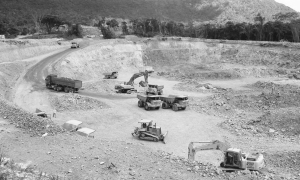Shutting down one Brazillian gold mine before starting up another left Troy Resources (TRY-T, TRY-A) with a net loss of A$5.4 million ($4.9 million) for the second half of 2007.
Troy CEO Paul Benson says the loss was expected. The company ended production at its Sertao gold mine in Goias state last August, and then moved the processing plant 1,100 km north to the Andorinhas underground and open-pit gold mine in Para state. Commissioning of the plant began in December; the first gold pour was expected in February.
“This is a reasonable result considering the enormity of the change the company has gone through,” Benson said in a statement.
Troy listed on the Toronto Stock Exchange in January, after raising $22 million in its initial public offering of nearly 8.5 million shares at $2.60 each.
The company expects to produce 50,000 oz. gold per year at Andorinhas over five years at a cash cost of US$250 per oz.
The project holds probable reserves of 1.2 million tonnes grading 6.51 grams gold per tonne for about 255,000 oz. gold.
Capital costs for the Andorinhas project were about US$20 million and the internal rate of return is about 50% at a gold price of US$550 per oz.
The Sertao mine produced about 1,400 oz. gold over the six-month period, compared with 8,200 oz. gold during the second half of 2006.
Exploration will be a big focus at Andorinhas as the company aims to lengthen the mine life. The company has increased its land position to 1,160 sq. km through a joint venture with Horizonte Minerals (HZM-L) for a 100% interest in its neighbouring Tangara project.
To own Tangara outright, Troy would have to pay Horizonte US$800,000 in option payments and spend US$2 million in exploration over three years. Troy would also have to pay a production royalty of US$30 per oz. gold up to 500,000 oz. gold; then a 1% net smelter return (NSR) royalty for gold production of 500,000 to 1 million oz.; and a 2% NSR on production beyond 1 million oz. gold.
Benson says the company will also complete an iron ore scoping study at Andorinhas to evaluate the potential for commercial production.
“If the results of that study are positive, we would aim to commence production of iron ore by the end of calendar 2008,” Benson says.
Overall, Troy produced 19,000 oz. gold in the second half of 2007 compared with 55,000 oz. in the same period the previous year.
Revenue was about A$22 million for the six months ended Dec. 31, 2007, compared with A$41.3 million in the second half of 2006, Troy recorded a profit of about A$7.3 million in last year’s second half.
The majority of gold production came from the company’s Lord Henry and Lord Nelson mines at the Sandstone project in Western Australia with about 18,000 oz. gold. That’s less than half the 47,000 oz. gold produced at the project over the same period in 2006.
Cash costs increased considerably — to about A$649 per oz. from A$281 per oz. the year before.
The company stopped mining the Lord Henry pit in December. Mill throughput was slower than usual because of the hardness and abrasive nature of the rock, resulting in higher power usage and lower throughput.
Troy signed a letter of intent last year with Western Areas (WSA-T, WSA-A) for nickel exploration at Sandstone. Western Areas can earn up to 51% in the nickel rights by spending US$4 million on exploration over four years, which could be increased to 70% by funding and completing a bankable feasibility study.
Troy has other exploration projects and interests in Mongolia, Ghana, Canada and Australia.


Be the first to comment on "Troy Resources posts $4.9M loss"